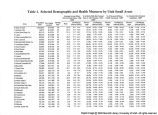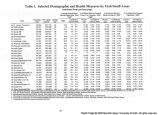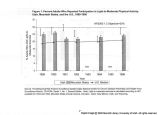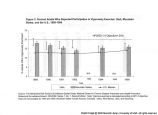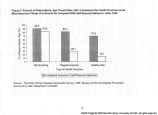| OCR Text |
Show Data Section 1: Utah's Demographic Characteristics The demographic characteristics of a given population provide a useful background in assessing its probable health status and its accessibility to health care. The tables and figures included in this section describe selected aspects of Utah's population and compare Utah with the nation. Utah's population size has been increasing at a rate above the national average. The increase in population can be explained by higher fertility and birth rates, lower death rates and by positive net-migration. Large and young families characterize Utah's population1. Utah leads the nation in the percentage of people living in family households (88.5%). Utah's family household size averages 3.15 persons and the average number of persons per family is 3.67 which also ranks Utah the highest among the nation in these categories. Examination of the population by age shows that nearly 35% of Utahns are 17 years or younger; those 65 and older make up 9% of the population. The remaining 56% comprise the working age population: those between the ages of 18 and 64. A statistic called the dependency ratio compares the sum of those aged under 18 and over 64 to the working age population. Utah has the highest dependency ratio in the United States. Utah's high proportion of young people is relevant to health issues because younger populations are generally healthier and utilize fewer health care resources. A younger population confounds comparisons of mortality rates if the comparisons are crude rates rather than age-adjusted rates. Utah will typically have lower crude mortality rates than the nation, even when Utah's death rates for individual age groups are the same or even higher than those for the nation. Age-adjusting standardizes rates to a standard population distribution, thereby adjusting for different age distributions. Thus, it is important to use age-adjusted rates when comparing Utah with the nation and when looking at trends. Considering the ratio of males and females in a population helps to understand probable health events such as breast cancer, heart disease, and many others. Data on sex are included in the Demographics section and again throughout the Health Status section. Measuring the health status of minorities is important when assessing the population's health and when comparing Utah with other states. Generally, minority groups have had poorer access to high quality health care and are at an increased risk for health problems (for example, see Infant Mortality by Race/Ethnicity). Minorities comprise 6.2% of Utah's population. Another factor for understanding health in Utah is the variation in population density2. Seventy-seven percent of Utah's population is concentrated in four metropolitan counties (Salt Lake, Utah, Davis, and Weber) that cover 4% of Utah's landmass. The remaining 22% of Utahns reside in 25 rural and frontier counties that encompass 96% of the land. Health care is generally more accessible in metropolitan areas than in rural areas. Access to health care is an ongoing challenge for rural and frontier Utah counties. Utah shares many demographic and geographic characteristics with its surrounding mountain neighbors. Comparisons of Utah to the Mountain States are included in some of the demographic data. Mountain States, as defined by the U.S. Bureau of the Census, include Arizona, Colorado, Idaho, Montana, Nevada, New Mexico, Utah, and Wyoming. Per capita income and per household income in Utah are lower than national averages. Despite lower incomes, Utah has a relatively low proportion of its people living in poverty. Still, Utah rates for poverty, child poverty, and homelessness are a cause for concern. Those who are poorer generally have a higher risk for many diseases and have more difficulty accessing the health care system. Utahns complete high school and college at a rate above the national average. Education has positive effects on health care by providing individuals with the opportunity for better employment and employment-sponsored health insurance. Educated people tend to be more knowledgeable about good health practices and are better able to access the health care system. 1 State Economic Coordinating Committee (1997). Economic Report to the Governor 1997. Salt Lake City. p.63. 2 Task Force on Rural Health Policy Development (1993). Utah's Vision for Rural Health Care. Salt Lake City. p.37. 64 |









































